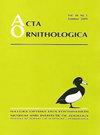Behavioural Responses of Adult and Young White Storks Ciconia ciconia in Nests to an Unmanned Aerial Vehicle
IF 1.3
4区 生物学
Q3 ORNITHOLOGY
引用次数: 8
Abstract
Abstract. Due to their falling cost, unmanned aerial vehicles, often called drones, are increasingly used as a tool in bird research and conservation. However, behavioural responses of birds to flying drones are still not well understood, for example do birds recognize drones as predators, as benign, or as neutral elements? How do they react to drones? We answered these questions and described the behaviour of birds toward drones during a study with White Stork Ciconia ciconia in north-eastern Poland. We used a small quadrocopter and noted flight initiation distances (FID) of adult storks on nests and behavioural reactions of their young towards drones. During nest inspections by drone, adult White Storks showed FIDs of between 1 and 20 metres, but occasionally did not even flush during drone approaches. FID was mainly affected by breeding stage, but some storks even ignored the working drones close to the nest (14%). Birds that escaped from the nest at the egg stage, returned to it on average within 23 seconds. The most common reactions of young White Storks to the drone were scaring (42%) and akinesis (34%). The rapid return of adult storks to the nest, even when scared away, shows that drones are not an highly invasive tool for examining their breeding outputs, even during the most sensitive period, i.e. egg stage. We believe that drones will soon become an important and common tool in research of the White Stork for determining breeding success and examining nests for hazards, e.g. waste, strings or electrocution risk. Our research can be a useful guide to researchers for predicting stork behaviour during inspection of their nests in the near future.巢中成年和幼龄白鹳对无人机的行为反应
摘要由于成本下降,无人驾驶飞行器,通常被称为无人机,越来越多地被用作鸟类研究和保护的工具。然而,鸟类对飞行中的无人机的行为反应仍然没有得到很好的理解,例如,鸟类是否将无人机视为捕食者,良性的,还是中性的元素?他们对无人机有什么反应?我们回答了这些问题,并在波兰东北部与白鹳Ciconia Ciconia进行的一项研究中描述了鸟类对无人机的行为。我们使用小型四旋翼飞行器,记录了成年鹳在巢上的飞行起始距离(FID)和它们的幼鸟对无人机的行为反应。在无人机检查巢穴时,成年白鹳显示出1至20米的盲区,但偶尔在无人机接近时甚至不会冲水。FID主要受繁殖阶段的影响,但部分鹳甚至忽略了靠近巢的工作雄蜂(14%)。在产卵阶段逃离巢穴的鸟类,平均在23秒内返回巢穴。年轻的白鹳对无人机最常见的反应是害怕(42%)和愤怒(34%)。即使被吓跑,成年鹳也会迅速返回巢中,这表明,即使在最敏感的时期,即产卵期,无人机也不是一种高度侵入性的工具,可以检查它们的繁殖产出。我们相信,无人机将很快成为研究白鹳的一个重要和常见的工具,用于确定繁殖成功和检查巢穴的危险,例如废物,绳子或触电风险。我们的研究可以为研究人员在不久的将来预测鹳在检查巢穴时的行为提供有用的指导。
本文章由计算机程序翻译,如有差异,请以英文原文为准。
求助全文
约1分钟内获得全文
求助全文
来源期刊

Acta Ornithologica
生物-鸟类学
CiteScore
2.10
自引率
0.00%
发文量
14
审稿时长
>12 weeks
期刊介绍:
Publishes scientific papers (original research reports, reviews, short notes, etc.) and announcements from all fields of ornithology. All manuscripts are peer-reviewed.
Established in 1933 as Acta Ornithologica Musei Zoologici Polonici, since 1953 continued under the present title.
Published twice a year by the Natura Optima Dux Foundation under the auspices of the Museum and Institute of Zoology, Polish Academy of Sciences.
 求助内容:
求助内容: 应助结果提醒方式:
应助结果提醒方式:


